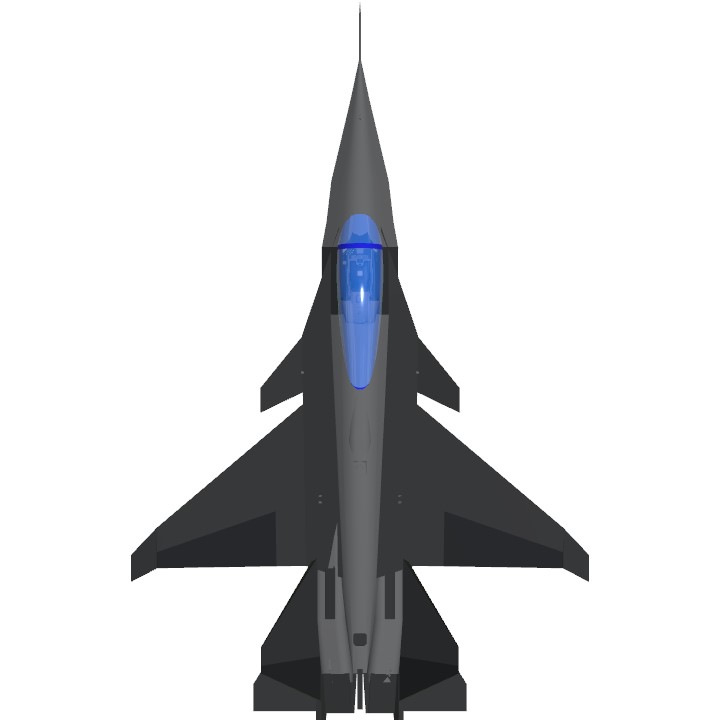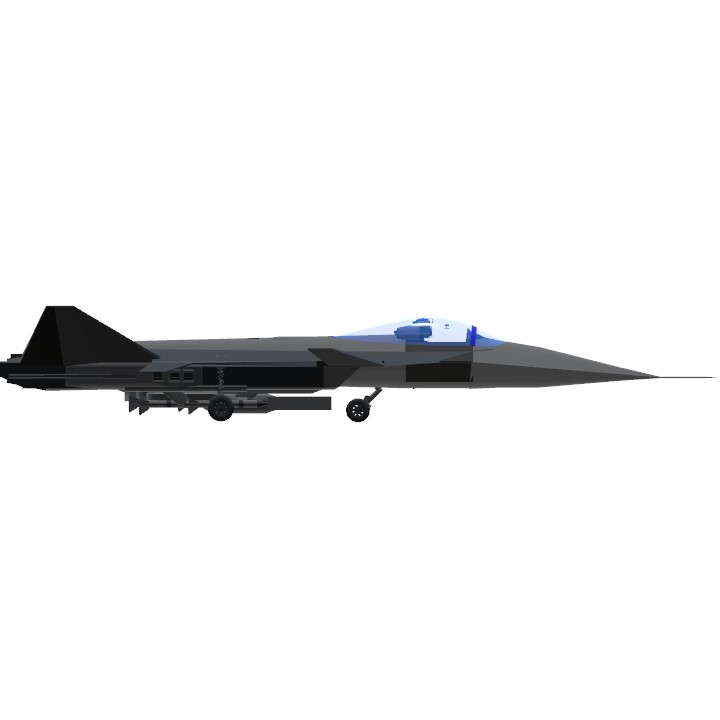"Invisible Until It’s Too Late."
-Official Motto of the LF-709
LF-709 Shadow: The Pinnacle of 6th Generation Naval Aviation
The LF-709 Shadow is an ultra-advanced 6th generation naval fighter jet developed by Clover Aerospace Division and proudly serving in the Taranian Navy. Built at the company’s headquarters in Aerensport, Tarania, Clover Aerospace Division has created an unmatched piece of naval aviation technology, designed to establish Tarania’s supremacy on the seas and in the skies.
A true testament to engineering excellence, the LF-709 Shadow combines stealth, agility, and cutting-edge technology to dominate modern naval warfare. Its radar-evading capabilities are exceptional, with RAM (Radar Absorbent Material) coatings applied to key areas, reducing its radar cross-section to the size of an ant. This makes the Shadow nearly invisible to enemy radar systems, enabling it to strike first while remaining undetected.
To minimize its infrared signature, the LF-709 uses Active Fuel Coating, a groundbreaking technology that reduces heat emissions and ensures the aircraft remains concealed from enemy IR tracking systems, even during high-speed maneuvers. This makes the Shadow an ideal asset for covert operations and precision strikes.
Despite its superior stealth and agility, the afterburners of the LF-709 present a tactical challenge. While they provide exceptional speed and thrust, they also create a visible IR signature, making the jet a potential target for heat-seeking missiles. As a result, afterburners are deployed sparingly during close combat, keeping the fighter’s stealth edge intact.
Where the LF-709 truly excels is in its supermaneuverability, made possible by an advanced 2D thrust vectoring system that allows for precise pitch and roll control. This enables the Shadow to perform extreme aerial maneuvers in combat, outmaneuvering even the most advanced enemy aircraft, whether in dogfights or evasive actions over the open ocean.
Designed for the challenging environment of carrier operations, the LF-709 is equipped with reinforced landing gear and a tailhook for rapid and reliable takeoffs and landings on Taranian aircraft carriers, even under the harshest conditions. With its blend of advanced avionics, next-gen weaponry, and stealthy design, the LF-709 is the premier asset in the Taranian Navy’s air combat fleet.
Performance Stats:
- Max Speed: Mach 1.25 (1,532 mph / 2,466 km/h)
- Super Cruise Speed: Mach 1.1 (1,320 mph / 2,124 km/h) with afterburners
- Endurance: Capable of sustained supercruise for up to 3 hours before reaching bingo fuel level
- Combat Radius: 700 miles (1,100 km) (optimized for naval operations and fuel consumption)
- Service Ceiling: 65,000 feet (19,800 meters)
- Carrier Operations: Reinforced landing gear and tailhook for carrier takeoffs and landings
- Weapons Systems: Capable of carrying a full complement of air-to-air and air-to-ground munitions, with external hardpoints designed for rapid deployment
- Radar Detection Range: Capable of detecting enemy aircraft from up to 450 miles (725 km) with advanced radar systems, ensuring early threat identification and tactical advantage
First Flight & Service Entry:
- First Flight: 2024
- Entered Service: February 9th, 2025 (coinciding with Clover Aerospace Division’s anniversary, marking a historic milestone for both the company and the Taranian Navy)
Lore:
The development of the LF-709 Shadow was born from a spirit of friendly competition between Tarania and Lykana, a neutral but highly respected nation known for its technological advancements. While Tarania sought to bolster its naval capabilities, Lykana was simultaneously working on its own 6th generation fighter, the Osiris—a formidable jet designed to rival the best in the world. The LF-709 Shadow was Clover Aerospace Division’s answer to Lykana’s technological challenge, and it quickly became a symbol of Taranian innovation. Though both countries shared a neutral relationship, the race for supremacy in the skies fostered a sense of camaraderie and mutual respect, pushing both nations to create some of the most advanced fighter jets the world had ever seen.
In the end, both the Osiris and the Shadow represent the pinnacle of their respective nations’ engineering prowess, each designed to outmaneuver and outlast any adversary. However, the rivalry between Tarania and Lykana remains friendly, each respecting the other’s achievements while striving to stay one step ahead in the race for aerial dominance.
The “Ruskovian Incident” - An Accidental Downing:
In early 2025, the LF-709 Shadow made headlines for an unexpected and somewhat controversial incident that occurred over the Taranian Ocean. While participating in a routine Taranian Navy exercise, a group of LF-709s were conducting a standard patrol, monitoring air traffic and ensuring maritime security.
During this exercise, a Ruskovian SU-35, on a patrol mission in neutral airspace, entered the area. While Ruskovia and Tarania maintained a neutral relationship, both nations frequently conducted patrols in overlapping zones, ensuring their respective sovereignty was upheld. As the SU-35 approached, Lieutenant Commander Jarek Solis, piloting one of the LF-709s, briefly lost situational awareness amidst the training's dynamic maneuvers. The LF-709's advanced radar system, designed to identify threats, mistakenly flagged the approaching SU-35 as a potential hostile due to its high-speed approach and rapid maneuvers, typical of an adversarial engagement.
Acting on the threat assessment, Lieutenant Commander Solis engaged the aircraft's advanced air-to-air missile system, and within seconds, a missile lock was established and fired. The missile hit its target, and the SU-35 was downed, stunning the entire task force. It wasn’t until after the fact that it was realized that the Ruskovian SU-35 was conducting a routine patrol, and there was no hostile intent.
The Ruskovian government immediately lodged a formal protest, demanding an investigation into the incident. While the Taranian government swiftly acknowledged the unfortunate error, calling it a misidentification during a routine exercise, the incident drew significant attention. In response, Tarania took swift action to resolve the situation diplomatically. The Taranian President personally issued an apology to the President of Ruskovia, expressing regret for the misidentification and assuring Ruskovia that such an incident would not happen again.
As a gesture of goodwill, Tarania offered Ruskovia a singular LF-709 Shadow as a token of apology, demonstrating not only their commitment to diplomacy but also their confidence in the aircraft's capabilities. The LF-709 was presented to Ruskovia as a symbol of peace and mutual respect, despite the tension caused by the incident.
To prevent any similar incidents from occurring in the future, Tarania and Ruskovia jointly developed a transponder system visible only to their respective military forces. This system would allow aircraft from each country to identify and distinguish one another from a safe distance, ensuring that misidentification would no longer lead to any further accidents.
The Ruskovian President, acknowledging the sincerity of Tarania's gesture, accepted the LF-709 and publicly praised the diplomatic resolution. The incident, now known as the “Ruskovian Incident,” became a defining moment in Taranian military diplomacy, underscoring the importance of careful identification and engagement in neutral airspace.
Despite the downing, the Ruskovian pilot of the SU-35 survived the ordeal with injuries. He was swiftly rescued by the Taranian Coast Guard, who responded to the emergency with professionalism and efficiency. The pilot was transferred to a nearby hospital, where he received medical attention. Under Tarania's long-standing policy, any foreign pilot ejected into Taranian territory—whether land or sea—is promptly rescued, treated for injuries, and then flown back to their home country once stable.
Following his recovery, the Ruskovian pilot was safely returned to Ruskovia under the protection of Taranian authorities, further cementing the commitment to humanitarian principles even during tense moments. This was a clear demonstration of Tarania’s unwavering dedication to professionalism, diplomacy, and adherence to international law.
Specifications
Spotlights
- SchmooveBrain 9 hours ago
General Characteristics
- Predecessor Ah damn! Got a leg cramp.
- Created On iOS
- Wingspan 27.5ft (8.4m)
- Length 43.6ft (13.3m)
- Height 7.6ft (2.3m)
- Empty Weight N/A
- Loaded Weight 28,682lbs (13,010kg)
Performance
- Power/Weight Ratio 2.503
- Wing Loading 68.8lbs/ft2 (336.0kg/m2)
- Wing Area 416.7ft2 (38.7m2)
- Drag Points 2756
Parts
- Number of Parts 224
- Control Surfaces 8
- Performance Cost 1,706







@CloverAerospaceDivision i'll do lol, gimme some time 😂
@SpetzavodHeavyIndustries Will you accept a singular one of this 6th Gen fighter for accidentally shooting down one of your jets, thinking it was an adversary?
Tag list 1:
@DrakonDynamics
@SchmooveBrain